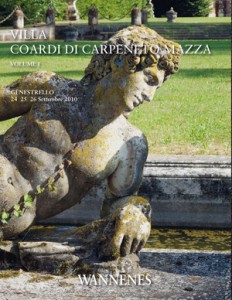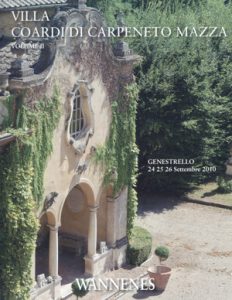Single Property
VILLA COARDI CARPENETO MAZZA
The large house belonging to the Coardi di Carpeneto Mazza family in Genestrello stands out beautifully upon a hill overlooking the valley of the River Po at the point where the Via Romea brushes past the village church. A mighty yet elegant building which, over the centuries, has set the stage for a whole host of greater (and lesser) events that have been tied to the history of Italy. Some were episodes in the life of the country of some importance, others were simply significant in social terms. Further episodes were linked, however, to the events and the sentiments of the families who lived in the house, generation upon generation. The main building is in the shape of an H with a central part from which two wings protrude in a north-westerly direction. Two further, lower, wings protrude in a south-easterly direction as was often the case in country mansions from the 18th Century onwards. The building sits harmoniously within the enormous gardens, landscaped all’italiana. These gardens were once set, in centuries past, among a much vaster estate. The origins of the house most probably date back to the 17th Century when the building, which had probably been once intended as a defensive construction, was transformed into a country mansion. The original residence had, indeed, been the property of the nobleman, Francesco Antonio Minazzi (or Minacci), the son of a certain Cabrino, until 1514. His heiress was most probably his daughter, Anna, thus enabling the property and her father’s whole estate to pass into the hands of her husband, Gerolamo Lunati, who belonged to an old noble family from Pavia. With their son and heir, Francesco, the Lunati family began their three hundred years of permanent residency at Genestrello: three centuries that reflected the careers of the noble families of the times. It was indeed Lunati who achieved the lucrative position of General Commissioner for the Duchy of Milan for the collection of taxes and dues for the possession of houses and salt. The rise, in social terms, of the family continued with the latter’s son, Antonio, who attained in 1692 the much sought-after feudal title of Marquis. The last of the Lunatis, another Antonio, was born in 1792. He became the Imperial Royal Chamberlain of His Majesty the Emperor of Austria and although he normally resided in Milan, he spent much of his leisure time at Genestrello, which was, at that time, actually beyond the confines of the Kingdom of Lombardy-Venetia. Antonio Lunati died in 1840, leaving his wife, Camilla Besozzi Figliadoni, as his heiress. She, in turn, having no descendants donated the mansion and the estate in 1854 to the Ospedale Maggiore in Milan. After three years, in 1857, the Hospital sold the mansion and estate at Genestrello to the Marquis Giorgio Pallavicino Trivulzio. The new owner was a man of certainly some considerable repute. He was the descendant of one of Italy’s oldest and most aristocratic families. He had been persecuted by the Austrians for having taken part in one of the secret Carbonari revolutionary societies and had been locked away for ten years at Spilberk Castele in Brno with other members like Pellico, Confalonieri, Maroncelli and other illustrious fighters for the Italian Risorgimento. His stay in the prison was not so harsh as it would seem since at the end of his term there the Marquis married the daughter of the prison director, Anna Koppman, who became the mother of their daughter, Anna. During these years, Genestrello was a much-loved home. The Marquis Trivulzio invited Giuseppe Garibaldi here in 1866 and Nino Bixio was a guest several times. Trivulzio died here in 1878. His only heiress was his daughter, Anna, the wife of the Marquis Alessandro d’Angrogna. She was as fond of the property as her father had been and made frequent short stays there up to a very old age. Upon her death in 1922, her two children had already passed away and her heir therefore became her nephew, Count Paolo Barbiano di Belgioioso. The latter had obviously not fallen under the spell of the house since he sold the property a year later to Ettore Gazzaniga, who had been Italy’s Ambassador to Argentina. He had married Giovanna Pichetto, whose family was established in Buenos Aires
ART EXHIBITIONS
Wannenes Art Auctions selcts the best Art Ehibitions and Events everywhere in the world




